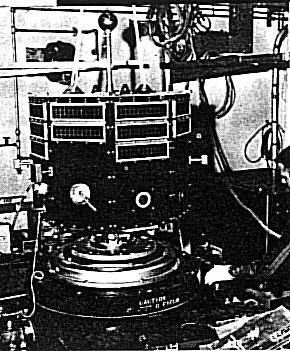
Home - Search - Browse - Alphabetic Index: 0- 1- 2- 3- 4- 5- 6- 7- 8- 9
A- B- C- D- E- F- G- H- I- J- K- L- M- N- O- P- Q- R- S- T- U- V- W- X- Y- Z
DME
 DME Credit: NASA |
AKA: Direct Measurement Explorer. Status: Operational 1965. First Launch: 1965-11-29. Last Launch: 1965-11-29. Number: 1 . Gross mass: 99 kg (218 lb).
The double-launch project, known as ISIS-X was the first in a new co-operative NASA-Canadian Defense Research Board program for International Satellites for Ionospheric Studies. Explorer 31 was in orbit with an apogee just over a kilometer more than Alouette's and with a perigee of just more than a kilometer lower. The orbits were some 3000 km at apogee and 500 km at perigee.
Explorer 31 was built for the NASA Goddard Space Flight Center, Greenbelt, Maryland, by the Applied Physics Laboratory of The Johns Hopkins University. Eight ionospheric measurement experiments sampled the environment both forward and after the satellite's path. Explorer 31 was 0.76 m across the top and was 25 inches high. A spherical mass spectrometer protruded 0.58 m above the top surface, making the total height 0.64 m. The satellite was powered by solar cells which covered about 15 percent of the spacecraft's surface.
NASA NSSDC Master Catalog Description
Explorer 31 was a small ionospheric observatory instrumented to make direct measurements of selected ionospheric parameters at the spacecraft. It carried seven experiments: a thermal ion experiment, a thermal electron experiment, an electrostatic probe, an electron temperature probe, a spherical mass spectrometer, an energetic electron current monitor, and a magnetic ion-mass spectrometer. Since the spacecraft had no tape recorder, data could be observed at the spacecraft only when the spacecraft was in sight of the telemetry station and when commanded on. Experiments were operated either simultaneously or sequentially, as desired. The satellite was spin-stabilized with the spin axis perpendicular to the orbit plane. The spin rate and spin axis were controlled by an onboard magnetic torquing system. The attitude and spin rate information were observed by a sun sensor and a three-axis magnetometer. Satellite performance was satisfactory except for a partial power failure in May 1966, which reduced data acquisition time to about half the nominal amount. Some difficulties were encountered in obtaining attitude information that was necessary for the reduction of the experiment observations. On July 1, 1969, the satellite data observations were terminated with five of the seven experiments operating. Responsibility for standby monitoring of the satellite was given to the ESSA telemetry station at Boulder, Colorado, on July 8, 1969. During this standby operation, experiment data were collected only once on October 1, 1969, for 9 min from the electrostatic probe for use in studying a red arc event. On January 15, 1971, no response was received from a variety of satellite commands, and the satellite was abandoned.
More at: DME.
Family: Earth, Ionosphere sat. Country: USA. Launch Vehicles: Thor, Delta, Thor SLV-2A Agena B, Thor SLV-2 Agena B. Projects: Explorer. Launch Sites: Vandenberg, Vandenberg SLC2E. Agency: NASA, APL. Bibliography: 2, 3700, 405, 6, 10973.
 | Explorer 31 Credit: Manufacturer Image |
1965 November 29 - . 04:48 GMT - . Launch Site: Vandenberg. Launch Complex: Vandenberg SLC2E. LV Family: Thor. Launch Vehicle: Thor SLV-2 Agena B.
- Explorer 31 - .
Payload: DME A. Mass: 99 kg (218 lb). Nation: USA.
Agency: NASA Greenbelt.
Program: Explorer.
Class: Earth.
Type: Ionosphere satellite. Spacecraft: DME.
USAF Sat Cat: 1806 . COSPAR: 1965-098B. Apogee: 2,833 km (1,760 mi). Perigee: 505 km (313 mi). Inclination: 79.80 deg. Period: 119.70 min.
Ionospheric research; data correlated with Alouette 2. The Explorer 31, Direct Measurement Explorer, was launched with a Canadian Alouette II on November 28, 1965, on a Thor-Agena rocket from Vandenberg Air Force Base, California. The double-launch project, known as ISIS-X was the first in a new co-operative NASA-Canadian Defense Research Board program for International Satellites for Ionospheric Studies. Explorer 31 was in orbit with an apogee just over a kilometre more than Alouette's and with a perigee of just more than a kilometre lower. The orbits were some 3000 km at apogee and 500 km at perigee. Eight ionospheric measurement experiments sampled the environment both forward and after the satellite's path.
Back to top of page
Home - Search - Browse - Alphabetic Index: 0- 1- 2- 3- 4- 5- 6- 7- 8- 9
A- B- C- D- E- F- G- H- I- J- K- L- M- N- O- P- Q- R- S- T- U- V- W- X- Y- Z
© 1997-2019 Mark Wade - Contact
© / Conditions for Use